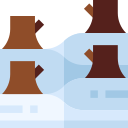Adaptive Management for Resilient Forests
Moving seed sources from warmer, drier regions within a species’ range can match future climates. Thoughtful trials safeguard genetic diversity, ensuring tomorrow’s forests inherit traits that tolerate heat, drought, and emerging pests.
Adaptive Management for Resilient Forests
Selective thinning reduces ladder fuels. Strategic breaks around communities protect lives. Prescribed burns restore natural fire intervals, recycling nutrients and creating mosaics that limit megafire spread while supporting fire-adapted species.


